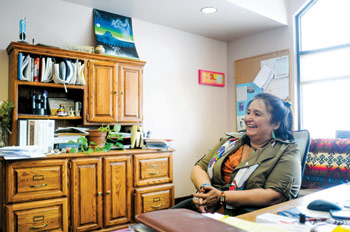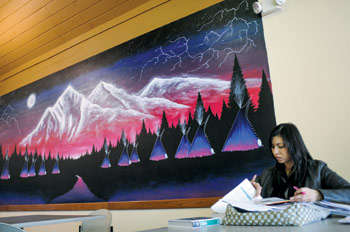BROWNING – Blackfeet Community College – a sprawling set of buildings on the edge of a town at the edge of the plains – means different things to different people. For Kelsey Wellman, 26, it’s a way to better her life and the lives of her two children in the place she calls home. For Andrew Heavy Runner, 22, it’s a ticket out, a way to “see the world and then come back.”
Browning’s two-year community college is growing and with about 470 students it is now offering more courses than ever before in its nearly 40-year history. In 2011, Blackfeet Community College opened a $5 million math and science building, the first tribal structure in the nation to be awarded Leadership in Energy and Environmental Design Platinum status. And two years ago it established a much-needed nursing program that has helped the surrounding community.
“Many of the people we serve here wouldn’t have access to education if it were not for BCC,” President Billie Jo Kipp said. “We are called upon to respond to the community’s needs.”
Yet even with these recent accomplishments, BCC has an uphill battle. Unemployment on the Blackfeet Reservation fluctuates from 60 to 80 percent and, in the last three years, less than 15 percent of students have graduated from the school. Kipp says the battle will get even harder with sequestration cuts that could reduce the school’s budget by more than half a million dollars annually.
“It means cuts to building maintenance, faculty, books, paper; cuts to everything,” she said. “It’s scary.”
The American Indian College Fund calls the nation’s 37 tribal colleges “underfunded miracles.” Blackfeet Community College was chartered in October 1974, two years after the Indian Education Act of 1972, and is primarily funded by the federal government. According to Kipp, tribal colleges receive about $5,000 per student. State universities usually receive an average of $12,000 per student.
BCC has also had a revolving door of leadership: In 11 years, it has had nine presidents. The college president is hired by a five-member board of trustees, which is appointed by the Blackfeet Tribal Business Council.
Despite these financial and administrative struggles, instructor Cindy Doore says the school has grown in recent years. Doore was raised in Cut Bank and taught in the public school system until 12 years ago when she came to BCC to teach science. When she arrived, she was the only instructor in her department. Today, there are four full-time and two part-time teachers. Doore was instrumental in starting the school’s practical nursing courses, which for two years were an extension of Flathead Valley Community College’s distance learning program.
 |
|
Billie Jo Kipp is seen in her office at the Blackfeet Community College in Browning. Lido Vizzutti | Flathead Beacon |
Doore said the courses have helped provide staff for medical facilities in Browning, Shelby and Cut Bank.
“It’s beginning to have an impact on the surrounding communities,” she said.
More improvements have taken place since Kipp arrived in November 2011.
Kipp was born and raised on the Blackfeet Reservation and graduated from the University of Montana with a doctorate in clinical psychology. She spent 10 years as a research professor at the University of New Mexico before coming home to take the head position at BCC.
“The goal of my education was to be of service to my people. That might sound cliché, but that’s the culture we are brought up in,” she said. “I felt the need to contribute to where I came from.”
Last year, Kipp created a student success center, which puts counselors and academic advisors in a centralized location on campus, a “one-stop shop,” as she put it. She reorganized academic departments so that each specialty had a head advisor that reported to the administration directly, creating more accountability. A new emphasis has been placed on workforce training programs to meet the needs of the community and this spring the college is hosting a welding class. Kipp has also instituted an open-door policy and tries to talk to as many students as possible to get their feedback.
But change has not come easy. Kipp says some community members resisted her ideas, and attributed that to the local culture.
“I think it’s deep seated in the native people because change has never been good for our people,” she said.
Professor Marvin Weatherwax Sr. said change from outside the reservation brought the suppression of Blackfeet culture and language for decades. Weatherwax has taught at the college since the 1970s and has made it his life mission to preserve the Blackfeet language.
Besides providing educational opportunities on reservations, tribal colleges were established to teach American Indians about their own culture and history, Weatherwax said. Blackfeet language is a requirement for graduation at BCC, with beginner and advanced courses offered.
The school has even developed a free iPhone app that teaches users basic terms. Weatherwax says there are only about 350 people who still speak the tribe’s native tongue.
“Our language is very quickly going away and we are in danger of losing it,” he said. “That’s a primary goal of a tribal college, to protect and preserve the culture.”
Lolo Arcand came to BCC to discover her native culture. Arcand was born in Browning but her family moved to Washington right after. Last year, she returned to the Blackfeet Reservation to spend time with her family and attend BCC.
Family is what brings a lot of students, like Andrew Heavy Runner and Kelsey Wellman back to Browning. Heavy Runner was living in Missoula until last year when his grandmother passed away. He moved back to assist his aging grandfather, but is hoping to return to Missoula for law school.
“I can really talk,” he joked between classes. “I’d be a good lawyer.”
“You can B.S. your way out of anything,” Wellman shot back.
Wellman is a single mother of two studying business administration and hopes to get a job in medical billing in a few years. She said going to school anywhere else would be hard for her with two kids. Having family nearby makes it possible.
“It’s just easy to be here because there is a support system,” she said.
But some of the support Wellman relies on could be gone next year.
The $85 billion in automatic, across-the-board federal budget cuts that went into effect on March 1, part of the sequester deal, could cut BCC’s budget by 5 percent next year. Kipp says that will take more than half a million dollars from the school’s $11 million annual budget. Advocates for tribal colleges warn that educational and community programs across Indian Country will suffer because of it.
 |
|
Lisa Running Crane works on her homework in the commons area at Blackfeet Community College in Browning. Lido Vizzutti | Flathead Beacon |
“Many tribal colleges are already operating on a shoestring budget and the cuts could have disastrous effects,” said Dina Horwedel, director of public education for the American Indian College Fund, in a recent interview. “They are making cuts across the board, and we understand that, but cutting funds to tribal colleges is going to hurt the poorest people in the United States and that doesn’t seem fair.”
Kipp doesn’t know the specific cuts facing the college but said nothing would kick in until next year. One possible target would be scholarships, something students like Wellman rely on.
“I kind of depend on that, especially when you’re a single mother of two. Daycare bills are a killer,” she said. “I don’t even want to start to think about it.”
If anyone understands what Wellman is going through, it’s Kipp.
In the 1970s, Kipp was a mother raising five kids and trying to go to BCC. She didn’t last long, and it wasn’t until 1993 that she finally returned to school.
“I know a lot because I’ve been there,” she said. “The problems haven’t changed, only the years.”
Even with all of the challenges, Kipp remains positive. You have to, she says, or the negatives will overwhelm “the big picture.” Kipp says she hopes to remain president for many years because stability in the school’s leadership will help it grow. Part of that big picture is someday turning the community college into a four-year institution, she said. However, if the school can continue to grow and serve its community, she’ll be happy.
“(This school) has a purpose, because for some of our people, this is the only education they will ever receive,” she said. “It has to survive and thrive.”